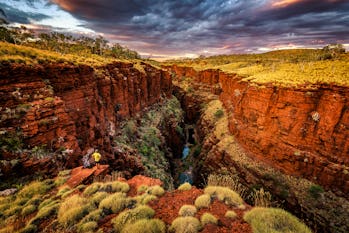
BOOM
ANCIENT AUSTRALIAN VOLCANIC ROCK MAY HOLD THE SECRET TO LIFE ON EARTH
Could volcanoes be responsible for creating the conditions for life on Earth to flourish?
TARA YARLAGADDA
8.9.2021
THE PILBARA REGION OF WESTERN AUSTRALIA offers stunningly strange vistas of volcanic rock and granite domes that feel reminiscent of an ancient world — and for a good reason.
These arid mineral-rich lands support Australia’s mining and crude oil industries, but they also reveal remarkable geological secrets about ancient Earth long before humans roamed the planet.
According to new research, the Pilbara Craton — one of the few crusts remaining on Earth from the Archaean era 2.7 to 3.6 billion years ago — could help us understand the emergence of Earth’s most essential ingredient for life: oxygen.
Scientists published their findings Monday in the journal Proceedings of the National Academy of Sciences.

The Knox Gorge at Karijini National Park in Pilbara, Western Australia.Getty
HOW THEY DID IT — A team of researchers in the U.S and the United Kingdom joined forces to analyze mercury in samples from the upper and lower parts of Mount McRae Shale, which is a 2.5-billion-year-old deposit of iron, mudstone, and other minerals in the Pilbara Craton.
Before humans dwelled on Earth, atmospheric mercury emerged largely as a result of volcanic events. The scientists theorized that analyzing mercury in rock from Mount McRae Shale could help confirm their suspicions about early Earth by linking volcanic activity to the formation of an oxygen “whiff” roughly 2.5 billion years ago.
WHAT’S NEW — Embedded in the ancient rock, scientists found patterns of mercury enrichment that correlate with oxidative weathering. Oxidative weathering occurs when oxygen interacts with rock minerals, changing the composition of the rock.
Based on their findings, researchers believe that oxidative weathering of volcanic ash and rocks generated essential elements like phosphorous, thereby supplying a vital nutrient to Earth’s oceans and generating the “whiff” of oxygen that occurred in Earth’s atmosphere.
The scientists conclude: “We hypothesize that the weathering of these flood basalts may have delivered nutrients such as [phosphorous] to the ocean and promoted primary productivity and thus the whiff of oxygen in its aftermath.”
In other words, intense, ancient volcanic activity may have been responsible for delivering the essential ingredient for life to the Earth.

According to the researchers, “intense volcanism” may have helped generate oxygen — an essential ingredient for life.Getty
WHY IT MATTERS — Most research on oxygen during the ancient Archaean era has focused on the Great Oxygenation Event, which occurred roughly 2.4 billion years ago. This event brought oxygen to early Earth’s oceans and atmosphere, creating the conditions for life to eventually flourish.
But previous research has shown that a brief, so-called “whiff” of oxygen emerged on Earth roughly 2.5 billion years ago, which meant that there was oxygen on Earth for 500 million years before the Great Oxygenation Event.
Scientists have long puzzled over the source of this strange whiff of oxygen, wondering where on Earth it came from. But with this new finding out of western Australia, researchers may have finally cracked the science behind this strange blip of oxygen.
Without oxygen, life on Earth could not flourish. Oxygen is what separates our “pale blue dot,” as Carl Sagan put it, from the countless other planets in the universe that cannot sustain life.
It’s never been entirely clear what exact conditions in Earth’s atmosphere led to the emergence of this life-giving element, but the new research suggests that it may have entered Earth with a volcanic boom.
WHAT’S NEXT — The scientist’s hypothesis is promising, though they’d like to conduct further research to bolster their case. The researchers write that their detection of phosphorous “following volcanism appears likely and warrants further scrutiny.”
Further research may yield more evidence connecting volcanism to the “whiff” of oxygen before the Great Oxygenation Event.
With this study’s findings, we are one step closer to unlocking the secrets of ancient Earth and understanding how its ancient geological mechanisms allowed life to form.
Abstract: Earth’s early atmosphere witnessed multiple transient episodes of oxygenation before the Great Oxidation Event 2.4 billion years ago (Ga) [e.g., A. D. Anbar et al., Science317, 1903–1906 (2007); M. C. Koehler, R. Buick, M. E. Barley, Precambrian Res.320, 281–290(2019)], but the triggers for these short-lived events are so far unknown. Here, we use mercury (Hg) abundance and stable isotope composition to investigate atmospheric evolution and its driving mechanisms across the well-studied“whiff” of O2recorded in the∼2.5-Ga Mt. McRae Shale from the Pilbara Craton in Western Australia[A.D.Anbaretal.,Science317, 1903–1906 (2007)]. Our data from the oxygenated interval show strong Hgenrichment paired with slightlynegativeΔ199Hg and near-zeroΔ200Hg, suggestive of increased oxidative weathering. In contrast, slightly older beds, which were evidently deposited under an anoxic atmosphere in ferruginous waters[C. T. Reinhard, R. Raiswell, C. Scott, A. D. Anbar, T. W. Lyons, Science326, 713–716 (2009)], show Hg enrichment coupled with positiveΔ199Hg and slightly negativeΔ200Hg values. This pattern is consistent with photochemical reactions associated with subaerial volcanism under intense UV radiation. Our results, therefore, suggest that the whiff of O2was preceded by subaerial volcanism. The transient interval ofO2accumulation may thus have been triggered by diminished volcanicO2sinks, followed by enhanced nutrient supply to the ocean from weathering of volcanic rocks causing increased biological productivity
No comments:
Post a Comment